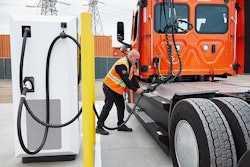The Environmental Protection Agency in its final "Phase 3" greenhouse gas emissions rule issued Friday did not specify any sort of emissions technology to help manufacturers meet the new emissions standards. The rule made clear, however, that electric vehicles will likely play a key role. As such, EPA included in the rule requirements for manufacturers that will help protect the end user.
In addition to the emissions-reduction standards finalized in the rule, EPA is also instituting battery durability monitoring and warranty requirements for batteries and other zero-emission truck components.
EPA said that because of the expected increased role of electric trucks in some form or fashion – battery-electric vehicles (BEVs), plug-in hybrid electric vehicles (PHEVs) and fuel-cell electric vehicles (FCEVs) – it included “requirements to ensure that such vehicles certifying to EPA standards are durable and capable of providing the anticipated emissions reductions to which they are certified.”
Manufacturers will be required to provide a customer-facing battery state-of-health (SOH) monitor for all heavy-duty BEVs and PHEVs. This monitor will estimate, monitor and communicate the vehicle’s state of certified energy, giving customers an estimate of the truck’s current state of health of the battery, in terms of the state of its usable battery energy (UBE) expressed as a percentage of the original UBE when the vehicle was new.
“We are finalizing new battery durability monitoring to apply for MY 2030 and later HD BEVs and PHEVs as a key step in assuring the emission reductions projected for this program will be achieved in use,” EPA said.
Manufacturers will also be required to warranty its batteries and “emissions-related components.” EPA identified the high-voltage battery and the powertrain components that depend on it (including fuel-cell stack, electric motors, and inverters), as “emission-related components” for the purposes of the rule.
The agency said it believes it has “defined which components are covered, while leaving the requirements general enough to cover technologies that are not currently in the market.” In its proposal last year, EPA received comments asking the agency to also define what failures are covered under the emissions warranty, but the agency decided to leave that up to the manufacturers, “as the current warranty requirements already provide the framework for manufacturers to define the specific failures that are covered under warranty, as they have done for many years.”
EPA is sticking with its proposed minimum warranty periods of 5 years or 50,000 miles for light heavy-duty vehicles and 5 years or 100,000 miles for medium and heavy heavy-duty vehicles.
[Related: EPA announces new strict emissions rule for heavy trucks]











